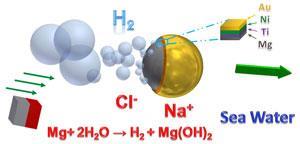Seawater can be used as fuel to propel micromotors say scientists in the US. This finding eliminates the need for external fuels by enabling the micromotors to harvest energy from their surrounding environment.

Joseph Wang and his colleagues from the University of California, San Diego, have designed micromotors that consist of biodegradable and environmentally friendly magnesium microparticles and a nickel–gold bilayer patch for magnetic guidance and surface modification. Typically, ‘other catalytic microscale motors rely upon hydrogen peroxide as an external fuel source, but this requirement impedes many important applications for such tiny motors,' explains Wang. Instead, these micromotors are fuelled by seawater and rely on the hydrogen bubble thrust generated from the magnesium–water reaction. ‘They [the micromotors] display efficient and prolonged propulsion in chloride-rich environments, like seawater, owing to the chloride pitting corrosion processes. The presence of the gold bilayer also enhances the magnesium–water reaction and leads to efficient motion in seawater,’ says Wang.
Alexander Kuhn, an expert in autonomous microswimmers, based at the University of Bordeaux, France, thinks this work is an important contribution. ‘The most appealing aspect here is that no external fuel has been added to the solution in order to generate motion,’ he says. ‘In contrast to most other literature concepts, the fuel is already integrated in the swimmer in the form of a reactive metal, in this case magnesium, which undergoes a spontaneous reaction with water. This well-known chemical reaction is confined in a clever way on a single particle and the two fuel components, water and magnesium, ultimately form hydrogen bubbles that drive the propulsion,’ Kuhn adds.
Continuous streams of hydrogen microbubbles are released from the exposed magnesium surface, causing the micromachine to be self-propelled at high speeds of over 90µm/s – nearly three body lengths per second.
Preliminary investigations by Wang and his team have shown that the micromotors can be used to capture and transport oil droplets from contaminated seawater. Carrying the droplet does, however, greatly decrease their speed (to 44µm/s) and the micromotors do currently have a limited lifetime. But the water-powered motion capability should at least expand their scope, particularly as they already show considerable potential for environmental remediation.






No comments yet